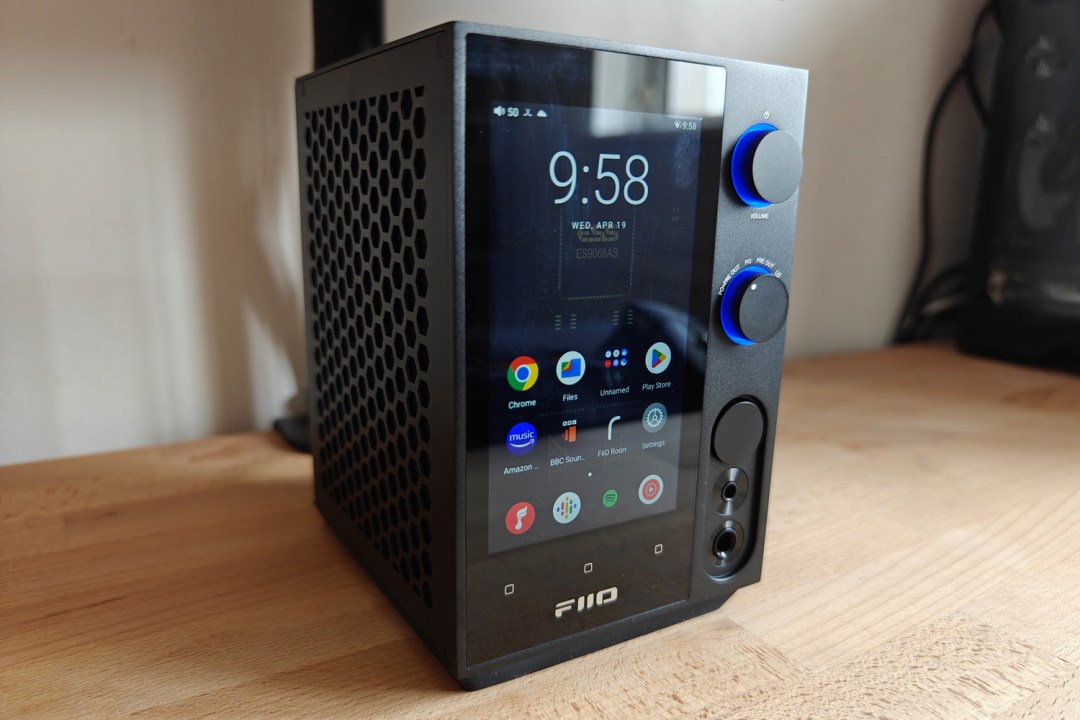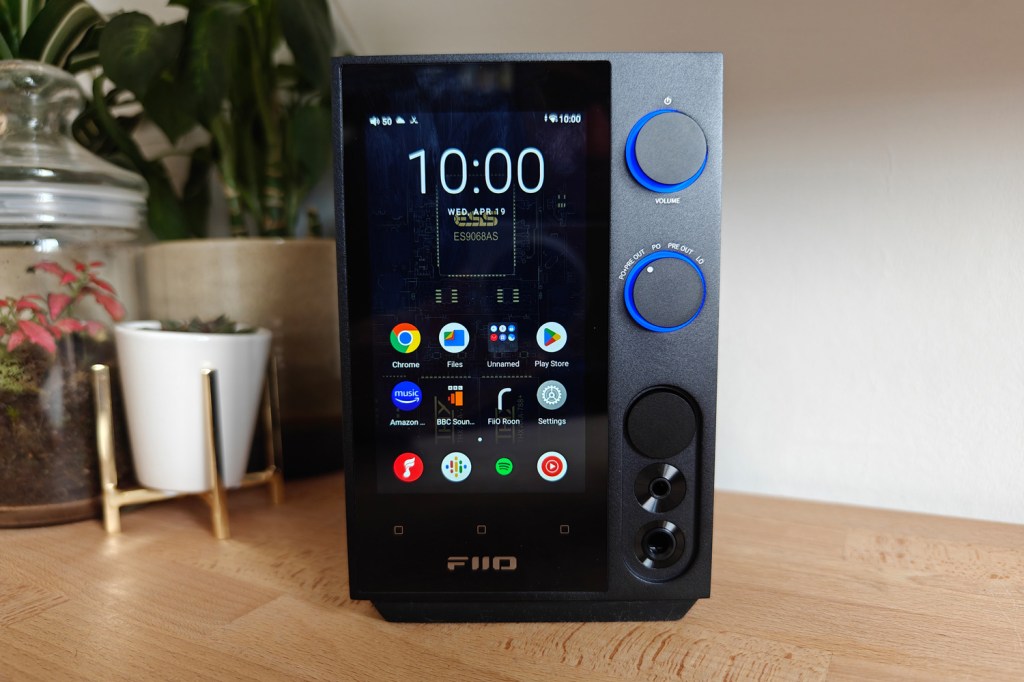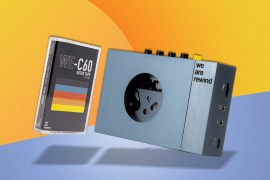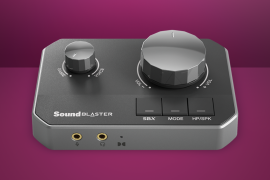FiiO R7 review: a thoroughly modern micro system
Hi-res wired and wireless playback from this all-digital music system

FiiO is perhaps best known for its portable music players – and very good portable music players they are indeed. But what if you prefer to do all your hi-res listening at home? No bother, the Chinese audio expert now has you covered there too. The $750/£650 FiiO R7 is equal parts music streamer and high-end headphone amp, crammed into a diminutive desktop unit that takes up considerably less room than a stack of separates.
With enough inputs and outputs to hook up pretty much any bit of audio gear, an Android-based interface that’ll play nicely with every streaming service, and a sizeable screen to control it all with, the R7 seems like the complete package for music lovers not looking to power a huge surround sound setup. But it’s also FiiO’s first attempt at an all-in-one. Has it delivered at the first time of asking?
Fiio R7 design & build: box of tricks



Taking up about as much desk space as a stack of CDs (remember those?), the FiiO R7 is wonderfully compact. It looks pretty slick, as black metal boxes of tech go, with honeycomb mesh side panels that let the internal circuitry breathe and a portrait-oriented touchscreen taking up most of the front. Once paired with set of FiiO’s upcoming SP3 speakers (still in development at the time of writing) and we get proper early Naughties micro system vibes.
FiiO has squeezed in two dials and a trio of audio outputs to the right of the 5in display, saving you from reaching around to the rear of the unit every time you want to plug in some headphones. A dust cover in the box blanks off those outputs completely if you don’t plan on using them, and there’s a single cover for the beefy XLR port to keep things looking shipshape.
The volume dial needs no explanation, but the output selector beneath it might. You can swap between headphones + preamp; just headphones; just preamp; or line out; the latter turns the R7 into a dedicated DAC, in case you’ll be plugging it into another amplifier. Headphones + preamp lets you hook up some active speakers or a subwoofer as well as a pair of cans.
The system itself sits flat, which can make viewing the screen a little tricky as it doesn’t have the best viewing angles. FiiO includes two rubber bases in the box to provide a bit of tilt, with sticky pads holding everything in place. Five degrees isn’t very much, though. The FiiO R7 might be a steal compared to certain high-end streamers, but it isn’t cheap, and this feels a little too DIY. There’s an optional remote control, though we’d prefer that it was included in the box.
FiiO R7 interface & features: phone it in



Power up the FiiO R7 and you’ll be greeted by an interface that’ll feel very familiar to anyone with an Android smartphone. There are a few visual tweaks, and the selection of preloaded apps is very stripped-down, but it’s very easy to navigate and effortlessly customisable. The handful of touch sensitive buttons beneath the display feel a bit redundant now gesture navigation is built into the OS, though. The screen gets satisfyingly bright, so it’s never a challenge to see the currently playing track.
Power comes from a Qualcomm Snapdragon 660 CPU and 4GB of RAM, which would’ve been considered mid-range in the phone world a full six years ago, but there’s still enough muscle to run your music player of choice. FiiO includes its own, of course, with DLNA server support as well as local playback – either from the 64GB of on-board storage, via an SD card, or from a USB flash drive.
Android 10 might be a rather outdated version of Google’s software, but you do have full access to the Play Store (as well as FiiO’s own app store), so can download pretty much any streaming service you fancy. Album art takes a half-second longer to load here when you first open Spotify than it does on a modern smartphone, but the UI is otherwise responsive enough to your taps and swipes. You can also swap the R7 into Pure Music mode, which shuts off most of the Android features and locks down the UI exclusively to Fiio Music.
The volume and output dials are surrounded by RGB indicator LEDs, which change colour depending on what source you’re playing. It’ll be blue for lossy playback from the likes of Spotify, cyan for 16-bit PCM tracks under 1000kbps, yellow for anything higher (indicating High Quality), green for DSD and magenta for MQA. It’s a handy way to make sure you’re getting the most from your Tidal Masters subscription.
FiiO R7 connectivity: plenty of ports



The balanced 4-pin XLR, 6.35mm and 4.4mm headphone ports up front should clue you in that the R7 is fully loaded when it comes to connections.
Around the back you’ll find optical and coaxial digital in and out, two pairs of standard phono RCA line outs, and two balanced 3-pin XLRs for hooking up a pair of active speakers. There’s also pair of USB ports – one Type-C and one Type-A. The former handles data transfers and also has a DP output mode, letting you hook the R7 up to a TV or monitor; the latter can handle external DACs, hard disks or peripherals.
Wireless connectivity is almost as extensive, with Wi-Fi and Bluetooth that supports the AAC, SBC, aptX HD, LDAC and LHDC codecs for cable-free listening without giving up too much sound quality. There’s AirPlay on-board, and it’s Roon ready for adding to an existing multi-room, multi-device setup.
You can even abandon the built-in AC power supply for an external DC unit, although we found the sound output was perfectly clean straight out of the box.
Is there anything missing? An analogue line input, maybe, but we’re nitpicking at this point.
FiiO R7 sound quality: powerful performer


It might only have a single DAC, but the ESS ES9068AS at the heart of the FiiO R7 is brilliantly capable. It has 32bit/768kHz PCM, DSD256 and MQA support, and is backed up by dual THX AAA-788+ headphone amplifiers to deliver 3000mW to your cans across five gain levels. Higher quality capacitors and a stronger power supply help it deliver audio that eclipses that of the already excellent M11S portable player.
120 steps of volume let you fine-tune even the most sensitive sets of headphones, with an ultra-low noise floor ensuring there’s nothing distracting you from the music. It has the oomph to drive just about anything through its balanced output, too. We used a pair of Sendy Apollo planar magnetic over ears, which performed with fantastic precision, but it also lets more affordable equipment like the Sennheiser IE200 IEMs sing.
Just like the M11S, the R7 is an enthusiastic and engaging listen, with well-controlled yet impactful bass that exhibits plenty of detail. The midrange is expressive and precise, without being crowded by the rest of the frequency range, and the soundstage is satisfyingly spacious. You can really crank the volume yet the clarity remains.
It’s at its best with a high quality source, be it an MQA-encoded Tidal Master or DSD, with lossy streams sounding slightly more enclosed, but the R7 still does a good job with whatever you choose to feed it.
FiiO R7 verdict

More than ‘just’ a network streamer or desktop DAC, the FiiO R7 is a brilliantly flexible player that can handle pretty much any source you care to throw at it, and play it back through almost any pair of headphones regardless of cable or connection.
The alternatives are all physically larger and cost more. The Android UI would perhaps benefit from a little more out-of-the-box customisation to make the most of the large screen, and we’d love to see a remote included for convenience, but it otherwise leaves you wanting for very little.
If you’re trying to squeeze a whole lot of audio kit into a very tiny space, the R7 will absolutely get the job done.
Stuff Says…
A compact media player/amplifier with all the connectivity you could want for hi-res listening. The Android UI isn’t quite as slick as pricier rivals, but means you have your pick of streaming services.
Good Stuff
Plenty powerful for personal listening
Android UI is straightforward to use
Loads of ports for expanding your system later
Bad Stuff
Where’s the remote control?
UI could be cleaner
FiiO R7 technical specifications
| DAC | ESS Sabre ES9068AS |
| Outputs | 4-pin balanced XLR, 4.4mm balanced, 6.35mm unbalanced (front) Dual XLR out, 2x RCA, Digital optical, digital coaxial (rear) |
| Inputs | Digital optical digital coaxial, USB-A (host) USB-C (data), Ethernet, external power (optional) |
| Screen | 4.97in, 720×1280 LCD touchscreen |
| CPU | Qualcomm Snapdragon 660 |
| Memory | 4GB RAM |
| Storage | 64GB onboard, SD expansion |
| Operating system | Android 10 |
| Dimensions | 110x134x160mm, 1.28kg |



